Petunia in pots: the best varieties, planting and care rules
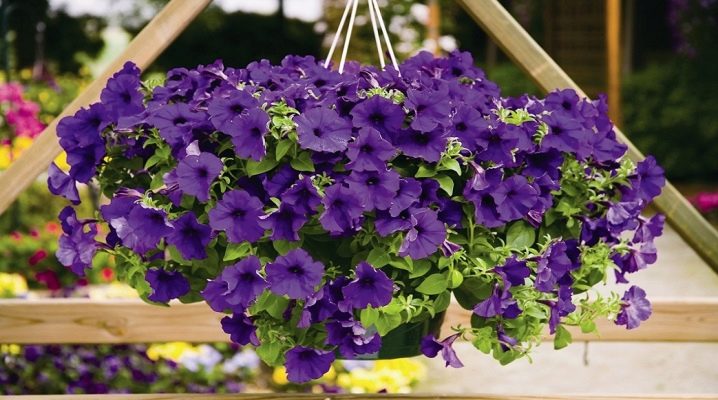
Petunia is the queen of verandas and balconies, who forever conquered the hearts of flower growers. What types and varieties of petunias to choose for planting in a hanging planter, how to care for plants in order to get abundant flowering - read everything in this article.

Suitable species
This flower from the Solanaceae family appeared on European territory in the 18th century. For the fabulous flowering and the abundance of bright colors, the culture fell in love with the gardener, especially the townspeople. Hanging pots with gorgeous flowers decorate balconies, loggias, terraces, summer grounds, turning them into a paradise. To create such beauty, you need to know what types and varieties of plants to buy.
For planting in hanging pots, ampelous and cascading petunias, which are somewhat different from each other, are suitable.


Ampel petunia:
- has thin shoots up to 1.2 m long;
- fragile lashes of plants break in heavy rain and gusty winds;
- like all ampelous, the plant directs its shoots down, like colored streams;
- looks spectacular in hanging pots, balcony boxes, high floor flowerpots around houses;
- in the color of one inflorescence, several colors are combined.

Cascading petunia:
- has dense strong stems up to 1.5 m long;
- not afraid of bad weather;
- the plant develops, directing the stems up, and then numerous branches descend in a smooth cascade, resembling a fluffy ball;
- looks great in hanging containers, amazingly weaves into graceful hedges, serves for vertical landscaping of garden pavilions, summer grounds and balconies;
- the colors of the cascading petunias are luxurious, rich.
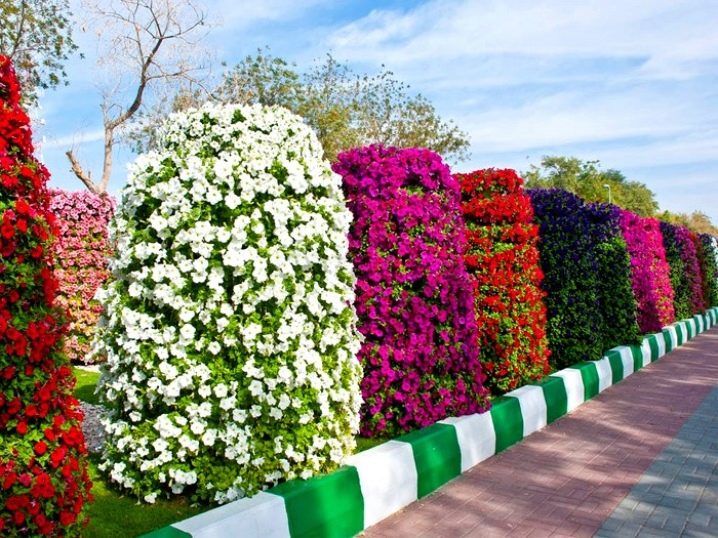
Flowering in both species is abundant and prolonged - almost until the frost. Inflorescences are small and large in size, simple and terry, with a delightful fringed edge.
The best varieties for hanging planters
Ampelny
Breeders all over the world are working on the development of new varieties of this beautiful plant. Luxurious ampelous hybrids of petunias - surfinias, tumblers and conchita.
- Surfinia has many colors and shades, the culture blooms beautifully, flowers are more than 9 cm in diameter.

- Tumbelins are distinguished by beautiful double inflorescences. The flower is resistant to cold weather and disease, but demanding on lighting and careful care.

- Conchita resemble profusely blooming surfinia: the inflorescences of the plant are small, 5 cm in diameter, there are ordinary and double.

All named series of varieties reproduce only vegetatively - by cuttings.
The best varieties of ampelous petunias
- "Mashenka" - a variety with lovely pink flowers and a bright yellow center. The scourge of the plant is less than 1 meter, branching densely.

- "Black Velvet" - an amazing variety with large velvety flowers of deep black color. Looks great in contrast with petunias of other colors, for example, red and snow-white.

- "Explorer" - large-flowered variety with long lashes, weather-resistant. Has many colors.

- "Catherine" - a hybrid with rich pink inflorescences of a salmon shade, luxuriantly blooming.

- "Svetlana" - petunia with meter shoots, blooming profusely until the end of summer.

- "The Snow Queen" - the very purity and tenderness. Large flowers emit the finest aroma.

- Diamond pearly shedes - the variety is very elegant, has delicate pink flowers.

- "Opera supreme" - small-flowered variety.Unpretentious, grows even at home, with good care it blooms all year round.
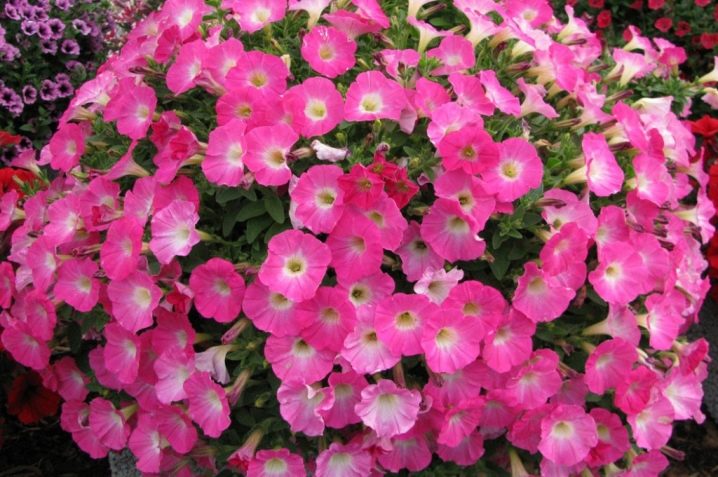
- "Avalanche" - an excellent option for balconies and loggias, it grows not just luxuriantly, but violently, assimilates any hedges and floristic forms. The colors are very different.

- Easy wave red - a hybrid variety with ruby-colored stars that glow with scarlet fire in emerald green.

- "Velveteen" - a wonderful variety with small velvety flowers, blooms very generously. Good for giving, as it is an excellent honey plant.

- Table yellow - a lemon-colored variety with orange veins, sunny, bright, goes well with other flowers.

- "Wave of Luck" - generous and long flowering, excellent endurance. The flowers are large, odorless.

Cascading
The cascading varieties include the following petunias.
- "Double Cascade" - a variety with large and fragrant flowers of bright colors.
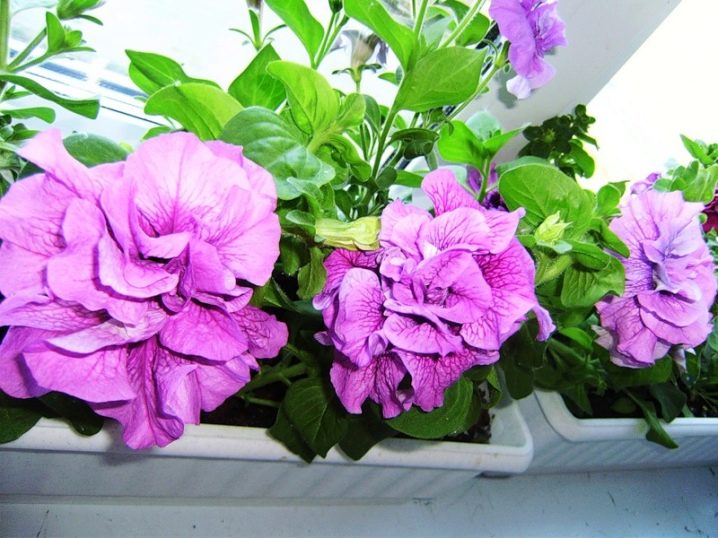
- "La Gioconda" - forms a powerful cascade of greenery and flowers, blooms magnificently all summer, is the most abundant of all cascading representatives.

- "Typhoon" - excellent flowering: long-lasting, abundant.
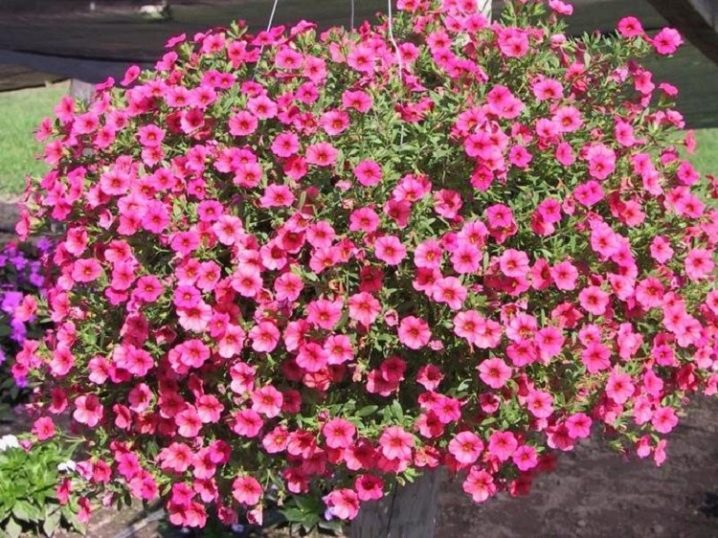
- Tornado F1 Cherry - a huge petunia with powerful branchy shoots. Grows quickly, resistant to wind and rain.

- "Blue waterfall" - a double variety with large flowers over 10 cm in diameter, flowers of deep blue color.

- "Super cascading white" - a branched, immensely flowering bush, covered with snow-white "gramophone" with a diameter of about 13 cm.
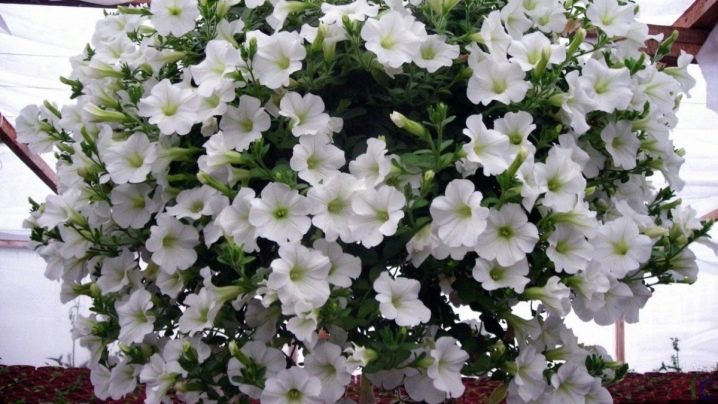
- Ramblin Peach - enchanting continuous flowering. Excellent branching, not afraid of rain and wind.
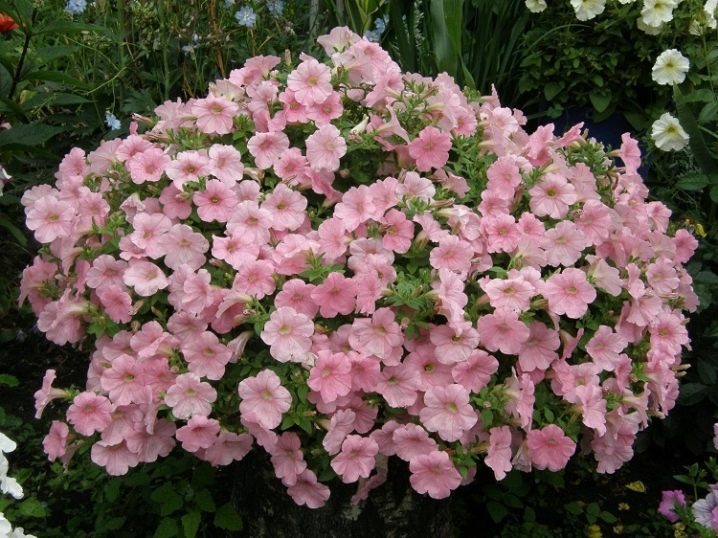
How to grow?
Landing
Petunia seedlings can be purchased in garden centers and markets, and you can take the risk of planting and growing wonderful flowers yourself.
- Purchase petunia seeds from Western producers.
- The best seeds are those covered with a protective coating of fertilizers (pelleted).
- Mix the soil: sod land - 1/5 part; sand - 1/5 part; humus - 1/5 part; peat - 2/5 parts.
- Disinfect the substrate in the microwave or oven to get rid of harmful bacteria and pests.
- Prepare plastic boxes with drainage holes for seedlings.
- Pour damp soil into containers.
- Place the seeds carefully on the ground.
Important! Do not sprinkle petunia seeds, they must remain on the surface!

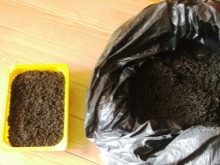

It is better to plant ampel petunia seeds in mid-February. Containers with crops are covered with glass or foil and placed in a warm shaded place. They do not need to be watered or sprayed.
Seedling care
The sprouted sprouts are transferred to a bright place and left in the greenhouse until the first true leaves appear. The film is lifted in order to spray and ventilate the plant. To prevent decay of seedlings, a weak solution of potassium permanganate is added to the water. When the seedlings have grown, they are watered into a tray. Excess water must be removed. Now, in the evening, seedlings need additional lighting.

With the appearance of the next pair of leaves, the plants dive into separate cups with loose soil and put on the south window. The room temperature should be no higher than 20 degrees. Plants are hardened by opening the window for a while. Fresh cool (but not frosty) air is good for petunias. The first fertilizing with mineral fertilizers is applied with the appearance of the fourth leaves.

We plant in the pots correctly
The grown and strengthened sprouts are planted in a permanent place in a flower pot on the street around May 10. To form a lush bush, several plants are planted in one planter.
- A pot with a capacity of 6 to 7 liters is suitable for one petunia.
- For 2-3 plants, you need pots with a volume of at least 15 liters.
- Planting of plants is carried out clearly at the point of growth, not deeper.
- It is better to plant petunias in the evening, in cool, calm weather.
- Correctly plant bushes in boxes and pots in well-lit places.

We grow a beautiful petunia
In order for a beautiful bush to grow from a small sprout, you need to follow all the rules for caring for the plant.
Watering
The plant loves good watering. In summer, when it is hot, petunia can be watered every day, but in moderation, so that moisture does not form in the pots. After watering, the soil in the pot is loosened so that the soil dries quickly and the roots receive enough air. The container with plants must have good drainage. In cloudy weather, the plant is not watered.
If the soil with petunia is waterlogged, the leaves of the plant turn yellow, the stem becomes watery. The flower is not watered for several days until the upper part of the substrate dries out, and the diseased leaves are cut off, the wounds are sprinkled with activated carbon.

Fertilizers
Petunia loves good food. In the summer, you can fertilize the plant every day along with watering, but in doses reduced by 2 times. If you plant petunias in the country, but you are not there every day, apply a prolonged-release fertilizer when planting plants in a pots. This saves you the hassle of feeding your plants all season.
If the summer is not dry, you can fertilize the crop 2 times a week. The first top dressing is done two weeks after planting the seedlings in pots. A nitrogen-containing fertilizer is used to stimulate shoot growth.
In the future, it is necessary to feed petunias for abundant flowering with complex fertilizers, the main components of which are potassium and phosphorus.

Formation
Petunia is a demanding plant to care for. Growing secrets:
- good lighting;
- correct watering;
- good nutrition;
- correct formation of the bush.

In order for the petunia to be branched and bloom generously, it must be pinched. Making petunias is done by pinching in the following sequence.
- The first pinching is carried out on seedlings with 4–5 leaves. With sharp scissors or fingers, they remove the growth point - they cut off the very top of the elongated shoot, leaving 2 leaves on it. After that, new growth will emerge from the lateral buds.
- The second procedure for removing the growth point is carried out after the appearance of the lateral processes in order to enable them to receive more nutrition and get stronger.
- The third pinching is carried out in a month. When the shoots grow back and begin to look out over the edge of the pots, again pinch off the extreme point of growth.
- If the petunia variety is vegetatively propagated, you can cut off 5 cm cuttings and root them.
- Axillary shoots will actively move into growth, the plant will have many lashes.
The flowering period will be postponed, but the time will come when the formed bush will bloom stunningly.


How to plant an ampelous petunia in a flowerpot, see the video below.







































































































The comment was sent successfully.